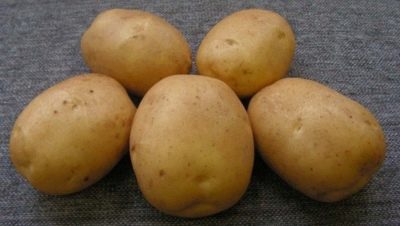
- Authors: Koksharov Vladimir Pavlovich, Klyukina Elizaveta Matveevna, Shanina Elena Petrovna
- Year of approval: 2002
- Appointment: dining room
- Tuber weight, g: 88-119
- Peel color: yellow
- Color of the pulp: white
- Starch content,%: 12,0-12,2%
- Tuber shape: oval-rounded
- Peel structure: smooth
- Flowers: medium, white
Leader is a variety of Ural origin, which attracts gardeners with its endurance and excellent survival rate. The taste characteristics of potato tubers are also at their best, which is why they are so appreciated. It is worth considering in more detail the main characteristics of the variety and the methods of its cultivation.
Description of the variety
The leader is table potatoes that can withstand mechanical harvesting. Standard characteristics of the variety:
bushes of medium height;
not a spreading crown;
medium-sized leaves of rich green color;
In the process of growth, potatoes release small white inflorescences.
Characteristics of the appearance of the bush and root crops
The leader grows into a medium-sized semi-erect shrub with large fruits. Tuber characteristics:
shape - oval;
size - medium;
weight - from 88 to 119 g;
the skin is smooth, dark beige.
The pulp of root vegetables has a creamy shade, is distinguished by its high density.
Purpose and taste of tubers
Root vegetables of potatoes have a juicy taste; potatoes are ideal for preparing main courses and frying. The total starch content in the root vegetable reaches 12%.
Maturation
On average, root crops have time to form in 65-75 days, which also pleases gardeners. The variety is suitable for planting in regions with difficult climatic conditions, it grows well both in the Urals and in the Far East.
Yield
The average yield per hectare is 330 centners. With proper care, it is possible to increase the parameter.
Growing and care
It is recommended to plant potatoes in early May, while the variety can be grown both in the open field and in greenhouses. The ideal planting temperature is 12 degrees Celsius. The best solution would be to go out into the garden on a cloudy but warm day.
Landing scheme.
The soil is fertilized and thoroughly loosened before planting.
On the day of planting, the holes are dug in advance, laying a layer of humus or other fertilizer of natural origin in them. The average depth of the hole should be 7 cm in dense soil, up to 13 cm in light soil.
When planting root crops, they maintain a distance between bushes of 30 cm, between rows - 65 cm.
After planting, the potatoes are watered abundantly and covered with foil or other dense material for a week.
The leader is a variety resistant to external influences and adverse conditions, undemanding to care. Basic recommendations.
Watering. Potatoes thrive in cool climates, but they can also withstand heat. The average frequency of watering is once a week. Volume - 2 liters of settled and slightly warmed up water per bush.
Loosening. The only thing potatoes need badly is good and regular aeration. Therefore, it is recommended to periodically loosen the tubers to saturate the soil with oxygen. On average, loosening is carried out once a week.
Fertilizer. The taste of root crops directly depends on the quality of dressings. Basically, gardeners recommend using organic compounds, laying out layers 30 cm thick. Occasionally, plantings are fed with superphosphate fertilizers or bird droppings. Another good fertilizer for potatoes is ash, which can be sprinkled on tubers when planting. You can also saturate the soil with ashes in the fall, before harvesting.
And also you can not do without hilling, so as not to let the variety rot or freeze.It is recommended to spud the bushes 2 times per season. The first time the land is raised when the bush grows 13-17 cm. The second time - before the potatoes flowering.

Planting potatoes is one of the main spring activities traditional for Russian gardeners. There are many ways to plant this vegetable, allowing you to get a good harvest in different conditions and climates. Before planting, you need to carefully prepare the planting material, correctly determine the timing, competently prepare the soil.


Soil requirements
Potatoes are undemanding to the planting site, however, in sandy loam or medium loamy soils, the variety demonstrates a high yield. The acidity of the soils should be neutral; if necessary, the desired indicator can be achieved with the help of fertilizers. Additional landing conditions:
small area;
sheltered from drafts and well-lit land;
it is better to carry it out in places where grasses, flax or winter crops grew.
In cooler regions, you can plant potatoes in a greenhouse. Before planting, it is recommended to germinate the tubers by placing them in wooden boxes for about 30-32 days. Additionally, it is worth taking out the potatoes in the sun for 5-6 days so that the seed material acquires a green tint. This approach will strengthen the immunity of the variety, making it more resistant to viruses.

Disease and pest resistance
Potatoes are highly resistant to diseases common for the species. The variety is not afraid:
dry rot;
rhizoctonia;
black legs;
spotting.
Weak immunity of the variety in relation to late blight. For prevention purposes, it is recommended to treat the bushes with Bordeaux liquid, using a solution of copper sulfate. And you can also use other formulations. It is important to process the bushes before they bloom, so as not to trigger deformation processes in the roots.

Potatoes are a popular vegetable crop that many gardeners planted on their site. But growing a bountiful harvest of tasty and large tubers is unlikely to succeed if the beds are not properly protected from the most common diseases and pests. Often, the development of diseases of various etiologies of potatoes goes unnoticed, so it is important to identify the problem in time and eliminate it.
















































































